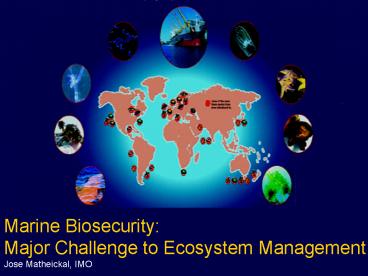Global Ballast Water Management Programme GloBALL - PowerPoint PPT Presentation
1 / 25
Title: Global Ballast Water Management Programme GloBALL
1
(No Transcript)
2
(No Transcript)
3
Common Marine Bioinvasion Vectors
Canals
Floating marine debris
Ships
Pleasure Crafts
Aquarium Pet Industry
Drilling platforms
Fisheries, Including Marine Aquaculture
(Mariculture)
Dry Docks
4
Governance, Legislation / Roles Responsibilities
5
Current and Future Challenges to Marine
Biosecurity
- Legal, policy and institutional arrangements to
implement existing international agreements - Lack of baseline knowledge to assist invasion
management - Substantial gaps at the intersection of science
and policy that are impeding biosecurity
management - Need for increased cooperation and coordination
among oceans institutions - Minimal capacity to deliver marine biosecurity
often low priority assigned and not enough
resources allocated
6
Climate change adds to the challenge
7
weakened ecosystems highly vulnerable for
invasions
Map Source Halpern et al, Science, February 2008
8
Black sea
Caspian Sea
9
(No Transcript)
10
Shipping and Marine Biosecurity
Shipping moves over 90 of world trade
11
(No Transcript)
12
Major Ports
MPAs
Ship Positions
13
- Ships Ballast Water and Sediments Major Vector
- Transfers 10 billion tonnes of ballast / year,
- Carries gt 7,000 species of microbes, plants and
animals at any one time, and
14
Hull Fouling important Vector
15
Global Response
- IMO-MEPC 1991
- IMO-Res. A.774(18) and A.868(20) in 1993 and
1997 - GEF-UNDP-IMO GloBallast 2000
- IMO-BWM Convention 2004
- Hull Fouling in IMO-MEPC Agenda 2008
16
- GloBallast A Catalytic GEF Intervention
17
18
- International Convention on Ballast Water
Management - - 2004
Presided by India and Vice presided by Brazil ,
South Africa Ukraine (All GB Pilots)
85 of countries who have now ratified the
Convention are from GloBallast Regions
South-North Transfer of GloBallast Tools and
Expertise
Built the Foundation for Global Partnerships
19
Phase 2 (2008-2012) The Legal, Policy,
Institutional Reforms
GBP Lead Partners
GBP Partners.
GB Pilots.
Piloting to Partnering Forging New Frontiers
20
Global Industry Alliance (GIA)
21
Marine Biosecurity Key strategies
- Building capacity (including research) to address
marine biosecurity issues - Developing economic policies and tools
- Strengthening legal and institutional frameworks
- Instituting a standardized system of risk
assessment - Building public awareness
based on GISP Strategies for Marine Bioinvasions
22
Marine Biosecurity Key strategies
- Promoting sharing of information
- Building responses to marine biosecurity into
other relevant sectors - Building marine biosecurity issues into global
change programmes - Promoting international cooperation on marine
biosecurity
based on GISP Strategies for Marine Bioinvasions
23
Some Recommendations
- Marine biosecurity should receive the kind of
management effort dedicated, for example, to
reducing marine pollution. - Global Forum on Oceans, Coasts and Islands to
include marine biosecurity as an ongoing theme /
sub-theme - Progress the CBD-GISP-UNEPRS Joint-Work Programme
on Marine Bioinvasions - Encourage GEF-LME Programmes to include marine
biosecurity as a priority issue - Bring industry onboard as early as possible
24
Some Recommendations
- Promote ratification and implementation of
existing international agreements (such as
Ballast Water Management Convention-2004)
25
http//globallast.imo.org
Forging Global Partnerships for Marine Biosecurity
Thank you































